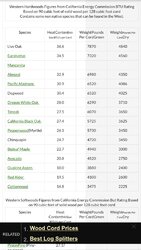As a California expat recently exiled to Wild and Wonderful West Virginia, I have been engaged in a study of east coast hardwoods, and their quality and suitability as fuel wood. Throughout the course of my studies, I have discovered such perennial favorites as Locust, Ash, Hickory, and Oak, due to their BTU ratings in the mid- to high-20s, which makes them a great choice when the Mercury drops into the teens, single-digits, and below.
I have also discovered, however, that the crown jewel of east-coast-BTU-rated fuel woods is the Osage Orange at a whopping BTU rating of 32.9! Wow!!
...But then I scroll down to the "West Coast Hardwoods" section of the chart, and discover that the tree varieties which not only grow in a region of the U.S. which boasts one of the most temperate of winter climates possible on Planet Earth, but also do so in such a prolific manner as to border on nuisance status.
The Live Oak and the Eucalyptus both grow to gargantuan specimen all throughout the moderate Central- and Northern-California coastal and foothill regions. These specimen also boast BTU ratings of 36.6 and 34.5, respectively! Oh, the irony of the most fuel-ideal trees growing in a region which seldom drops below 50 degrees Fahrenheit in the winter!
Sorry...rant over. Excuse me while I get back to processing my Shagbark Hickory with a paltry 27.7 BTU rating.
http://firewoodresource.com/firewood-btu-ratings/

I have also discovered, however, that the crown jewel of east-coast-BTU-rated fuel woods is the Osage Orange at a whopping BTU rating of 32.9! Wow!!
...But then I scroll down to the "West Coast Hardwoods" section of the chart, and discover that the tree varieties which not only grow in a region of the U.S. which boasts one of the most temperate of winter climates possible on Planet Earth, but also do so in such a prolific manner as to border on nuisance status.
The Live Oak and the Eucalyptus both grow to gargantuan specimen all throughout the moderate Central- and Northern-California coastal and foothill regions. These specimen also boast BTU ratings of 36.6 and 34.5, respectively! Oh, the irony of the most fuel-ideal trees growing in a region which seldom drops below 50 degrees Fahrenheit in the winter!
Sorry...rant over. Excuse me while I get back to processing my Shagbark Hickory with a paltry 27.7 BTU rating.
http://firewoodresource.com/firewood-btu-ratings/

Last edited:


